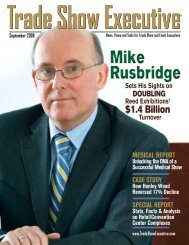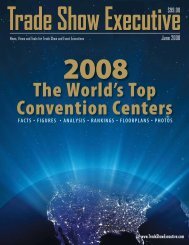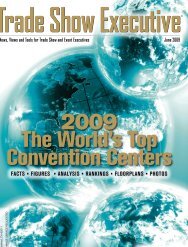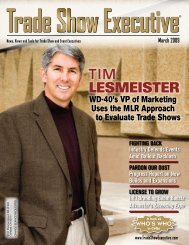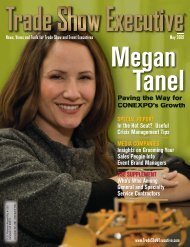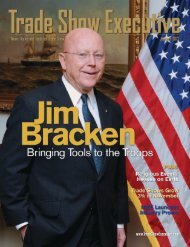Trade Show Executive
Trade Show Executive
Trade Show Executive
You also want an ePaper? Increase the reach of your titles
YUMPU automatically turns print PDFs into web optimized ePapers that Google loves.
TRENDING & SPENDING<br />
SPONSORED BY<br />
4th Quarter Decline<br />
in GDP is Not a Harbinger<br />
of Bad Times for 2013<br />
BY DARLENE GUDEA, president<br />
Oceanside, CA – Many of us have accepted<br />
the likelihood of slow growth for 2013,<br />
but were caught off guard when the<br />
Commerce Department announced<br />
that Fourth Quarter GDP went negative,<br />
falling (0.1)%. It was the first quarterly<br />
decline since the end of the Great<br />
Recession and a sharp “about face”<br />
from the 3.1% growth rate in the Third<br />
Quarter. Economists expected growth of<br />
about 1%. “The surprise contraction may<br />
raise fears about the economy’s ability to<br />
handle tax increases that took effect in<br />
January and the looming sequestration,”<br />
said Frank Chow, chief economist for<br />
<strong>Trade</strong> <strong>Show</strong> <strong>Executive</strong> Media Group.<br />
Already, a key measure of consumer<br />
confidence by The Conference Board<br />
plummeted in January after Americans<br />
noticed the reduction in their paychecks.<br />
Naturally, executives are wondering<br />
if this is the start of another recession.<br />
Chow believes the negative Fourth<br />
Quarter GDP number will be revised<br />
upward, noting, “The encouraging<br />
economic data and reports for December,<br />
as outlined in last month’s column,<br />
have not been fully captured in the<br />
GDP calculation.” He said export data<br />
takes longer to gather than most other<br />
economic information and there is<br />
evidence of a backlog of petroleum<br />
products shipments overseas at the end<br />
of the year. Also, a slew of corporations<br />
accelerated dividends into 2012 to avoid<br />
a tax increase that kicked in on January 1,<br />
2013. Dividend payments soared 50% in<br />
December to propel the biggest increase<br />
in personal income in five years. “I don’t<br />
believe the impact on spending has been<br />
recorded yet,” Chow said. Some analysts<br />
say the dividend increase will cannibalize<br />
future distributions in 2013, but Chow<br />
believes that is not certain because many<br />
companies have huge cash balances and<br />
shareholders are clamoring for a return<br />
of that cash in some form like dividends.<br />
Q4 Weakness is<br />
Not Likely to Stick Around<br />
Furthermore, most economists think<br />
a large segment of the Fourth Quarter<br />
weakness will not carry over into 2013,<br />
Chow noted. The two main factors<br />
causing the GDP decline were, (1)<br />
Defense spending dropped by the most<br />
in 40 years, and (2) Companies scaled<br />
back in restocking inventory. “Both<br />
situations are likely one-time events,”<br />
he said. “The defense cuts and inventory<br />
slowdown were cautionary reactions<br />
to the rancorous fiscal cliff debate. The<br />
eventual fiscal cliff agreement signaled<br />
to businesses that future fiscal deals<br />
will be greatly scaled back, thus likely<br />
encouraging spending and investment<br />
to return to normal soon,” Chow believes.<br />
So far in 2013, the economic data<br />
continues to support slow growth:<br />
• The Empire State Manufacturing Index<br />
moved into positive territory for the first<br />
time since last July. The index rose to 10.0<br />
in February from a negative (7.8) in the<br />
prior month. Economists expected to<br />
fall into the red to (2.0).<br />
• The January ISM Manufacturing Index<br />
increased to 53.1% from December's reading<br />
of 50.2%, indicating expansion for<br />
the second consecutive month. All five<br />
of its component indexes were above<br />
50% — new orders, production, employment,<br />
supplier deliveries and inventories.<br />
• The January ISM Non-Manufacturing<br />
Index was at 55.2%, down from 55.7% in<br />
December, but still indicating expansion.<br />
But the employment index rose to 57.5%,<br />
up from 55.3% in December.<br />
• Nonfarm payrolls expanded by 157,000<br />
in January, below forecasts of 185,000.<br />
The unemployment rate ticked up to 7.9%<br />
Darlene Gudea,<br />
PRESIDENT<br />
Frank Chow,<br />
CHIEF ECONOMIST<br />
as more people entered the labor force.<br />
A broader measure that includes underemployment<br />
was steady at 14.4%.<br />
• Retail sales barely rose 0.1% in January<br />
after a 0.5% rise in December as tax<br />
increases and higher gasoline prices<br />
restrained spending. So-called core sales,<br />
which strip out automobiles, gasoline and<br />
building materials, also ticked up 0.1%.<br />
Looking forward to<br />
the rest of 2013, there<br />
are two powerful trends<br />
gaining momentum in the<br />
U.S. One is the housing<br />
revival. The other trend is<br />
in energy. Last November,<br />
the International Energy<br />
Agency predicted the U.S.<br />
will become the world's<br />
top oil producer probably<br />
by 2020.<br />
Frank Chow, CHIEF ECONOMIST<br />
FOR TSE MEDIA GROUP<br />
• Industrial production slipped (0.1)%<br />
in January on declines in manufacturing<br />
and mining output, but only after<br />
the Federal Reserve significantly revised<br />
production for November and December.<br />
Housing Revival<br />
Looking forward to the rest of 2013,<br />
there are two powerful trends gaining<br />
www.<strong>Trade</strong><strong>Show</strong><strong>Executive</strong>.com | March 2013 17



